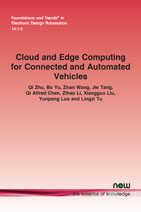Cloud and Edge Computing for Connected and Automated Vehicles
By Qi Zhu, Northwestern University, USA, qzhu@northwestern.edu | Bo Yu, PerceptIn, USA, bo.yu@perceptin.io | Ziran Wang, Purdue University, USA, ryanwang11@hotmail.com | Jie Tang, South China University of Technology, China, cstangjie@scut.edu.cn | Qi Alfred Chen, University of California, Irvine, USA, alfchen@uci.edu | Zihao Li, Purdue University, USA, zihao@purdue.edu | Xiangguo Liu, Northwestern University, USA, XiangguoLiu2023@u.northwestern.edu | Yunpeng Luo, University of California, Irvine, USA, yunpel3@uci.edu | Lingzi Tu, Southwest Jiaotong University, China, linzitu@outlook.com
Abstract
The recent development of cloud computing and edge computing shows great promise for the Connected and Automated Vehicle (CAV), by enabling CAVs to offload their massive on-board data and heavy computing tasks. Leveraging the Internet of Things (IoT) technology, different entities in the intelligent transportation system (e.g., vehicles, infrastructure, traffic management centers, etc.) get connected with each other, thus making the entire system smarter, faster, and more efficient. However, these advances also bring significant challenges to public authorities, industry, as well as scientific communities. In terms of system design and control, current cloud and edge architecture of CAVs need to be refined or even redesigned to better function under uncertainties in demand, and to better cooperate with existing conventional vehicles and infrastructure. From the performance assessment perspective, models and simulation tools based on artificial intelligence and big data have been widely developed for validation and evaluation of cloud computing and edge computing, but the validity of these models needs to be re-examined with field implementations.
Finally, while the increasing connectivity among vehicles and infrastructures may help improve their perception of the environment and enable coordinated decision making, it also presents new challenges to ensure system safety and security, with inherent disturbances to wireless communication networks and also the inevitably larger attack surface that may be exploited by malicious attacks. In this tutorial, experts from academia and industry will introduce the trends and challenges of applying cloud and edge computing for CAVs, highlight representative works in the literature and discuss their limitations, present new promising solutions, and outline future directions in research and engineering. Particular focus will be given to methodologies and tools for building digital twin frameworks with cloud and edge computing for CAVs, quantitative and formal analysis for ensuring CAV safety under disturbances and uncertainties, system-level CAV security threat landscape and defense solution space, and experiences from practical deployment of cloud and edge computing for CAVs.
Cloud and Edge Computing for Connected and Automated Vehicles
The recent development of cloud computing and edge computing shows great promise for the Connected and Automated Vehicle (CAV), by enabling CAVs to offload their massive on-board data and heavy computing tasks. Leveraging the Internet of Things (IoT) technology, different entities in the intelligent transportation system (e.g., vehicles, infrastructure, traffic management centers, etc.) get connected with each other, thus making the entire system smarter, faster, and more efficient. However, these advances also bring significant challenges to public authorities, industry, as well as scientific communities. In terms of system design and control, current cloud and edge architecture of CAVs need to be refined or even redesigned to better function under uncertainties in demand, and to better cooperate with existing conventional vehicles and infrastructure.
From the performance assessment perspective, models and simulation tools based on artificial intelligence and big data have been widely developed for validation and evaluation of cloud computing and edge computing, but the validity of these models needs to be re-examined with field implementations. Finally, while the increasing connectivity among vehicles and infrastructures may help improve their perception of the environment and enable coordinated decision making, it also presents new challenges to ensure system safety and security, with inherent disturbances to wireless communication networks and also the inevitably larger attack surface that may be exploited by malicious attacks.
In this tutorial, experts from academia and industry introduce the trends and challenges of applying cloud and edge computing for CAVs, highlight representative works in the literature and discuss their limitations, present new promising solutions, and outline future directions in research and engineering. Particular focus will be given to methodologies and tools for building digital twin frameworks with cloud and edge computing for CAVs, quantitative and formal analysis for ensuring CAV safety under disturbances and uncertainties, system-level CAV security threat landscape and defense solution space, and experiences from practical deployment of cloud and edge computing for CAVs.
